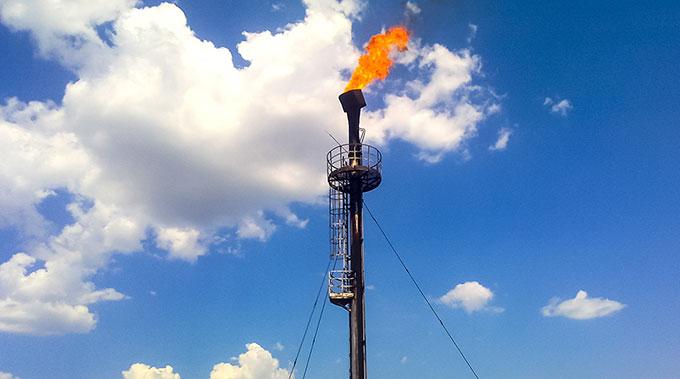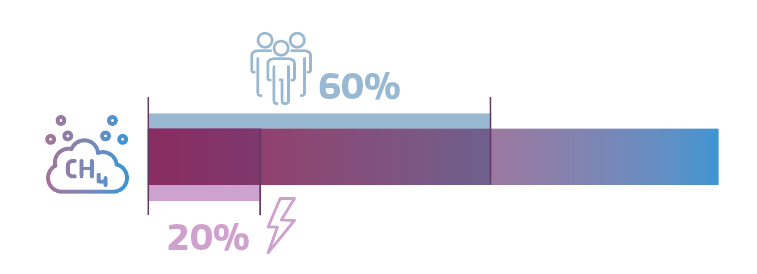
Responsible for 30% of today’s global warming – methane (CH4) is second only to carbon dioxide (CO2) in terms of its contribution to climate change.
Although the amount of methane in the atmosphere is considerably less than CO2, methane is 84 times more potent as a greenhouse gas, but only has a lifespan of around 12 years in the atmosphere. This means that it is capable of trapping heat much more effectively than CO2, and therefore makes a significant contribution to global warming, despite the smaller volume in which it occurs. It also means that action to reduce anthropogenic methane emissions today could significantly slow climate change before 2050.
What is meant by anthropogenic methane?
40% of the methane in today’s atmosphere occurs naturally, while 60% of the potent gas is ‘anthropogenic’, meaning it is the result of pollution caused by human activity.

Alongside the agriculture and waste sectors, energy is one of the leading contributors of anthropogenic methane emissions, with about 20% of the total global methane emissions arising from the energy sector: from the extraction, transport, distribution and use of oil, gas, and coal, as standard natural gas consists of 70-90% methane.
Methane is not only harmful to the climate and environment, but as a local air pollutant and contributor to ozone formation, it is seriously hazardous to human health in the unnaturally large volumes in which it exists in our atmosphere.
The International Energy Agency estimates that around 70% of methane emissions from fossil fuel operations could be reduced with existing technology, and about 40% at no net cost. A significant portion of these emissions occur from compressor leaks along pipelines and the harmful and overused practices of flaring and venting, whereby excess natural gas is either burned, often inefficiently, or released into the atmosphere in order to get rid of it.
EU actions on methane
Due to existing technology, its low cost, and methane’s short lifespan, cutting methane emissions offers the most immediate opportunity to slow global warming in the short-term, as the EU progresses towards its goal of full decarbonisation by 2050. The European Green Deal, launched in December 2019, proposes a series of actions to reduce the EU’s net greenhouse gas emissions by at least 55% by 2030 and aims to make Europe a climate neutral continent by 2050. One of them addresses the need for reducing energy-related methane emissions.
The Commission published its Methane Strategy in October 2020. It focuses on reducing methane emissions in the energy, agriculture and waste sectors, but it also promotes synergies across sectors, such as the production of biomethane. Biomethane is a sustainable substitute for fossil gas, which can be stored, distributed and used in the same infrastructure as fossil gas. Although the tailpipe emissions would be the same as for the fossil gas, biomethane allows for GHG emission savings along the production pathway, capturing GHG gasses from feedstock that would have been otherwise released to the atmosphere. The Commission’s REPowerEU plan, presented in May 2022, further emphasises the importance of biogas and biomethane by setting a target for production of 35 billion cubic metres per year by 2030.
The Methane Strategy also proposed new EU rules on the matter and the Commission adopted in December 2021 a proposal for a Regulation on methane emissions reduction in the energy sector (amending Regulation 2019/942).
The provisional agreement was reached in November 2023 and when officially published in 2024, the regulation will be valid in all EU countries 20 days later.
"This landmark agreement will allow us to seriously tackle the energy sector’s greenhouse gas emissions in the EU and beyond. This first-of-its-kind regulation enables the EU to curb methane emissions in a cost-effective manner, and address venting and flaring of gas, which make economically and environmentally little sense. This will benefit our planet and will also avoid wasted resources in tight global gas markets."
Kadri Simson, Commissioner for Energy
Global methane actions
As with climate change more broadly, concerted action on methane emissions at global level is essential, in addition to addressing the problem at EU level. The EU only accounts for 6% of global energy-related methane emissions, while as the largest oil and gas importer our imports account for around 30%.
As such, the regulation on methane emissions will require fossil fuel importers to provide methane emissions data from the end of 2024, which will be published in an EU database with country performance profiles from 2026. There will also be a requirement for importers to show that EU-equivalent measurement, reporting, and verification standards for methane emissions were used from 2027, and following a review, a methane intensity import standard from 2030.
Together with likeminded partners, the EU has been a leader in terms of driving a global response to reducing methane emissions. The EU co-convenes the Global Methane Pledge, launched by President von der Leyen and U.S President Biden at COP26 in Glasgow in 2021, the 155 signatories of which commit to reducing global methane emissions by 30% by 2030. More than 50 of these countries have developed national methane action plans to implement this domestically, or are in the process of doing so. A short animation explains the objectives of the Global Methane Pledge.
Most recently, at COP28 in December 2023, President von der Leyen announced €175 million in support of the Methane Finance Sprint to help drive global methane emission reductions and implement the Global Methane Pledge.
A significant portion of this is in support of the methane data revolution, the ongoing technological advancements in source, site, and space-based measurement and monitoring of methane emissions. This is being led by the EU-funded UNEP International Methane Emission Observatory (IMEO), which houses the Oil and Gas Methane Partnership 2.0 (OGMP 2.0) global framework and the satellite-based Methane Alert and Response System (MARS), used by the regulation to strengthen EU engagement with super-emitters. Building on both OGMP 2.0 and MARS, the observatory is working on the development of a Methane Supply Index of the emission intensity of global oil and gas production to be used by market participants to make purchasing choices based on emissions.
In support of the successful delivery of these initiatives, both at EU and global level, in November 2023 the Commission announced a new alliance with 12 countries to collaborate towards a globally aligned framework for measuring, monitoring, reporting and verifying (MMRV) greenhouse gas emissions, including in particular methane, in fossil fuel supply chains.
The Commission has also started to cooperate with a number of sub-Saharan, North African, and South American countries on the ‘You Collect, We Buy’ approach, whereby the EU facilitates the commercialisation of natural gas that would have otherwise been emitted, supporting both the climate and our energy security.
Related links
- Methane emissions - European Commission (europa.eu)
- Biomethane - European Commission (europa.eu)
- 2023 Global Methane Pledge Ministerial: decisive action to curb emissions (4/12/2023)
- Commission steps up ambition to agree on a global framework for the measurement, monitoring, reporting and verification of greenhouse gas emissions (15/11/2023)
- International Methane Emissions Observatory (IMEO)
- Video: Biomethane (EC AV portal – offering subtitles in 22 languages)
- Video: Global methane pledge (EC AV portal – English only)
Details
- Publication date
- 16 January 2024
- Author
- Directorate-General for Energy
